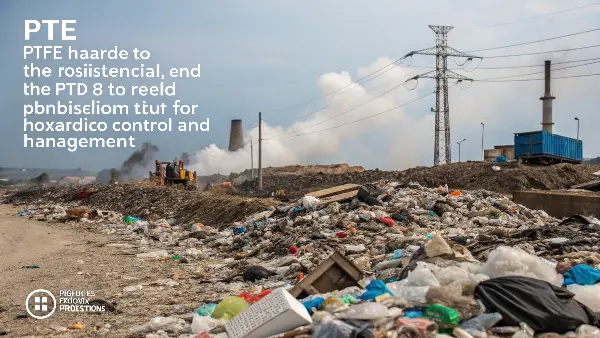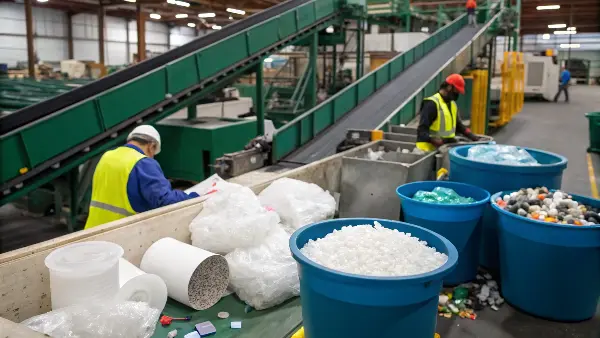We love PTFE for its unique abilities in demanding applications. But in today’s world, we also need to ask about its environmental footprint1 – from creation to disposal. Is it sustainable?
PTFE’s environmental profile is complex: production can be energy-intensive and historically involved controversial chemicals (like PFOA), while its durability means it persists, making end-of-life management and recycling challenging.
As mold makers and designers like Jacky strive for responsible material choices, understanding PTFE’s full life cycle is becoming essential. I’ve seen more clients asking these questions lately. It’s not a simple "good" or "bad" answer; we need to look at the whole picture. Let’s explore the environmental journey of PTFE.
The conversation around plastics and sustainability2 often focuses on single-use items, but high-performance materials like PTFE3 deserve scrutiny too. Their long life is a benefit, but what happens before and after?
What Are the Key Environmental Impacts During PTFE Production?
We rely on PTFE for critical parts, but how ‘clean’ is its manufacturing process? Ignoring the production phase gives an incomplete picture of its true environmental cost.
Producing PTFE involves energy-intensive processes and historically used perfluorooctanoic acid (PFOA), a persistent environmental concern, although manufacturers have largely phased it out. The main impacts relate to energy consumption and managing chemical inputs/outputs.
Diving Deeper: From Raw Materials to Polymer
The journey to a usable PTFE part starts well before molding or machining. Understanding the upstream impacts is crucial for a fair assessment.
- Raw Material Extraction & Synthesis: PTFE (Polytetrafluoroethylene) starts with basic elements, typically derived from mined fluorspar (calcium fluoride) and chemicals like chloroform and hydrofluoric acid (HF). Extracting these raw materials has its own environmental footprint (mining, chemical production). Synthesizing the monomer, tetrafluoroethylene (TFE), is a complex chemical process requiring careful handling due to the hazardous nature of intermediates like HF.
- Polymerization: Converting TFE gas into solid PTFE polymer requires significant energy under specific pressure and temperature conditions. This polymerization step is a major contributor to the material’s overall energy footprint.
- Processing Aids (PFOA/PFAS Concerns): Historically, PFOA was widely used as a surfactant (processing aid) in the dispersion polymerization method for making certain types of PTFE. PFOA is a type of PFAS (Per- and Polyfluoroalkyl Substance), known for its extreme persistence in the environment and potential health concerns. Due to regulatory pressure and public awareness, major manufacturers have transitioned away from PFOA, using alternative processing aids (often shorter-chain PFAS or non-fluorinated options) whose long-term environmental profiles are still under evaluation. This legacy issue, however, means older production sites might still be sources of environmental PFOA contamination.
- Energy Consumption: The overall process, from raw materials to the final polymer resin, demands substantial energy inputs, contributing to greenhouse gas emissions depending on the energy sources used by the manufacturing facilities.
While the industry has made strides, particularly in phasing out PFOA, the fundamental chemistry and energy needs mean PTFE production inherently carries environmental burdens.Is PTFE Environmentally Safe During its Use Phase?
PTFE parts are known for their stability and inertness, suggesting they should be safe during use. But are there hidden risks, like leaching or off-gassing, especially under certain conditions?
Generally, solid PTFE is highly stable, inert, and non-toxic during normal use within its specified temperature range. The main concern relates to toxic fumes released if PTFE is heated above approximately 350°C (660°F).
Diving Deeper: Stability and Potential Risks
Once a PTFE part is manufactured and put into service, its environmental impact shifts from production to its interaction with the surrounding environment.
- Chemical Inertness: This is a key benefit. PTFE resists degradation from almost all chemicals, meaning it doesn’t readily break down or leach harmful substances into its surroundings under normal operating conditions. This makes it suitable for sensitive applications like food processing (using specific grades) and medical devices.
- Biological Inertness: PTFE is generally considered biocompatible and doesn’t support microbial growth.
- Temperature Stability: PTFE performs reliably up to 260°C (500°F). Within this range, it remains stable and does not significantly degrade or off-gas harmful substances.
- Overheating Risk (Pyrolysis): The critical exception is overheating. If PTFE is heated above its upper service limit, especially beyond 350-400°C (660-750°F), it begins to decompose (pyrolysis). This process releases toxic fluorocarbon fumes, including particulate matter and gases like hydrogen fluoride (HF) and carbonyl fluoride, which can cause polymer fume fever in humans and are harmful to the environment. This is primarily an occupational safety concern during processing (e.g., machining without proper ventilation, accidental overheating) or in fire situations, rather than during normal product use.
- Wear and Microplastics: While durable, PTFE parts subject to friction (like bearings or seals) can wear over time. This wear can generate fine PTFE particles. While PTFE itself is inert, the long-term environmental fate and impact of these microplastic particles are part of a larger, ongoing area of research concerning all plastics.
So, during its intended operational life and within its temperature limits, PTFE is exceptionally stable and poses minimal direct environmental risk. The primary hazard relates to decomposition at very high temperatures.What Challenges Arise at PTFE’s End-of-Life?
PTFE’s durability is great for performance, but what happens when a PTFE part is discarded? Its resistance to degradation makes disposal a significant environmental challenge.
At end-of-life, PTFE does not biodegrade, persisting indefinitely in landfills. Incineration requires high temperatures and careful scrubbing to manage hazardous emissions (like HF), posing technical and environmental challenges.

Diving Deeper: Persistence and Disposal Difficulties
The very properties that make PTFE valuable during use – chemical inertness and thermal stability – become major hurdles when the part reaches the end of its functional life.
- Non-Biodegradability4: PTFE’s strong carbon-fluorine bonds make it extremely resistant to chemical and biological degradation. It does not break down naturally in soil or water over human timescales. This means PTFE waste persists in the environment for potentially thousands of years.
- Landfill Issues5: The most common disposal route is landfilling. Here, PTFE simply takes up space indefinitely. While it’s unlikely to leach harmful chemicals under normal landfill conditions (due to its inertness), its persistence contributes to the growing volume of plastic waste. There’s also the potential for physical breakdown into smaller microplastic fragments over very long periods due to physical forces, although not chemical degradation.
- Incineration Challenges6: Incineration can destroy PTFE waste and potentially recover energy, but it requires specialized facilities.
- Microplastic Formation: As mentioned earlier, PTFE items fragmenting in the environment (whether from landfill breakdown or improper disposal) contribute to microplastic pollution.
Effectively managing PTFE waste requires strategies beyond simple landfilling or standard incineration, pointing towards the need for better collection and recycling infrastructure.How Feasible is Recycling PTFE Waste?
Given the disposal challenges, can we effectively recycle PTFE? Recycling plastics is often touted as a solution, but PTFE’s unique nature makes it difficult and uncommon.
Recycling PTFE is technically possible through methods like regrinding/reprocessing or advanced techniques like pyrolysis, but it faces significant economic and logistical hurdles including contamination, collection difficulties, and degradation during reprocessing.

Diving Deeper: Recycling Methods and Hurdles
While not widely practiced compared to common thermoplastics like PET or HDPE, some methods for recycling PTFE exist, primarily for cleaner, post-industrial scrap.
- Mechanical Recycling (Regrinding/Reprocessing):
- Process: Clean PTFE scrap (e.g., machining swarf, off-cuts) can be ground into fine powder. This powder can sometimes be blended in small percentages with virgin PTFE resin for compression molding, typically for less demanding applications, as reprocessing can affect properties.
- Challenges: Contamination is a major issue; even small amounts of impurities can drastically alter performance. The heat history from original processing and regrinding can degrade the material, limiting its use. Filled PTFE grades are much harder to recycle this way as separating the filler is difficult or impossible. Collection and sorting of post-consumer PTFE waste is practically non-existent.
- Chemical Recycling (Pyrolysis/Upcycling):
- Process: Advanced methods like pyrolysis involve heating PTFE waste in controlled conditions (often oxygen-free) to break it down into its constituent monomers (like TFE) or other valuable fluorochemicals. These recovered chemicals could potentially be used to synthesize new virgin PTFE or other fluoropolymers.
- Challenges: These processes are energy-intensive, require sophisticated technology, and are currently expensive. Managing the potentially hazardous byproducts of pyrolysis is critical. The scale of such operations is very limited globally. Feedstock consistency is also a challenge.
- Economic and Logistical Barriers:
- Low Volume, High Value: PTFE is used in smaller quantities than commodity plastics, making dedicated collection streams difficult to establish.
- Cost: The cost of collecting, sorting, cleaning, and reprocessing PTFE often exceeds the cost of virgin material, hindering economic viability.
- Quality Concerns: End-users needing PTFE’s high performance are often reluctant to use recycled content unless its properties can be guaranteed, which is difficult.
While recycling offers a potential route to improve PTFE’s sustainability, significant technical and economic barriers currently prevent it from being a widespread solution, especially for post-consumer waste. Efforts often focus on recycling clean, post-industrial scrap within manufacturing facilities.Conclusion
PTFE presents environmental challenges, mainly from energy-intensive production and end-of-life persistence. Recycling is difficult, making responsible use and considering alternatives key aspects of sustainable design involving this unique material.
-
Exploring the environmental footprint of PTFE can help assess its sustainability compared to alternative materials. ↩
-
Investigating sustainability challenges in high-performance materials like PTFE can guide responsible design and manufacturing practices. ↩
-
Understanding PTFE’s environmental impact is crucial for making informed material choices in design and manufacturing. ↩
-
Understanding the environmental impacts of non-biodegradable materials can help in making informed decisions about waste management and alternatives. ↩
-
Exploring landfill issues related to PTFE can shed light on the broader implications of plastic waste and potential solutions. ↩
-
Learning about the challenges of incinerating PTFE waste can inform better waste management practices and energy recovery methods.
-
High Temperatures: Complete destruction requires very high temperatures (typically >800°C, often much higher) to break the strong C-F bonds.
-
Hazardous Emissions: Incomplete combustion or lower temperatures can generate highly toxic and corrosive gases, including hydrogen fluoride (HF), carbonyl fluoride, and potentially other harmful perfluorinated compounds. Effective flue gas scrubbing systems are essential to capture these emissions, adding complexity and cost to the incineration process.
-
Ash Residue: The resulting ash may still contain fluoride compounds requiring careful management.
-
